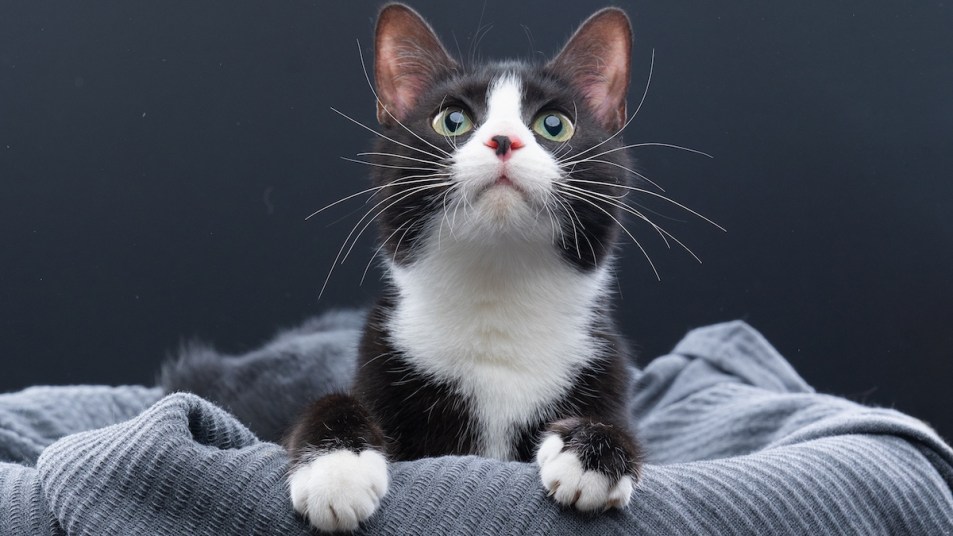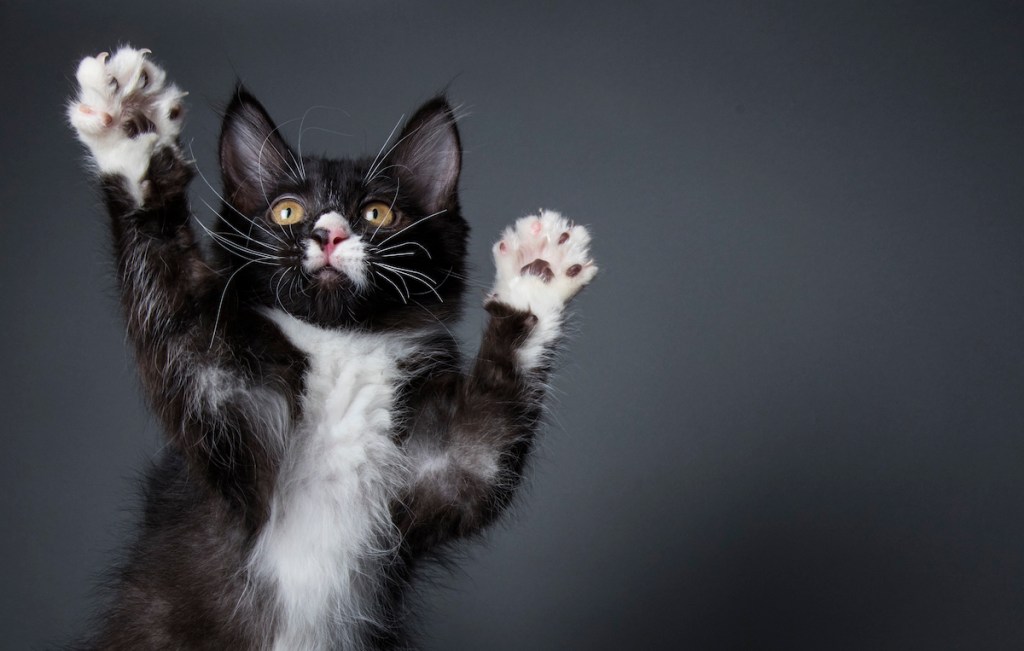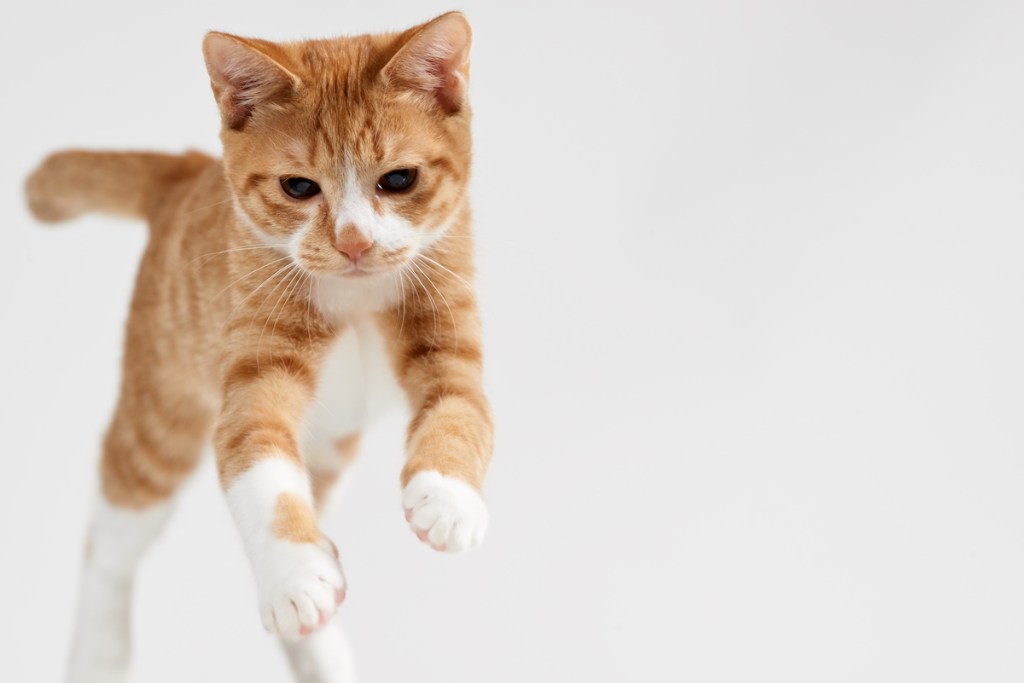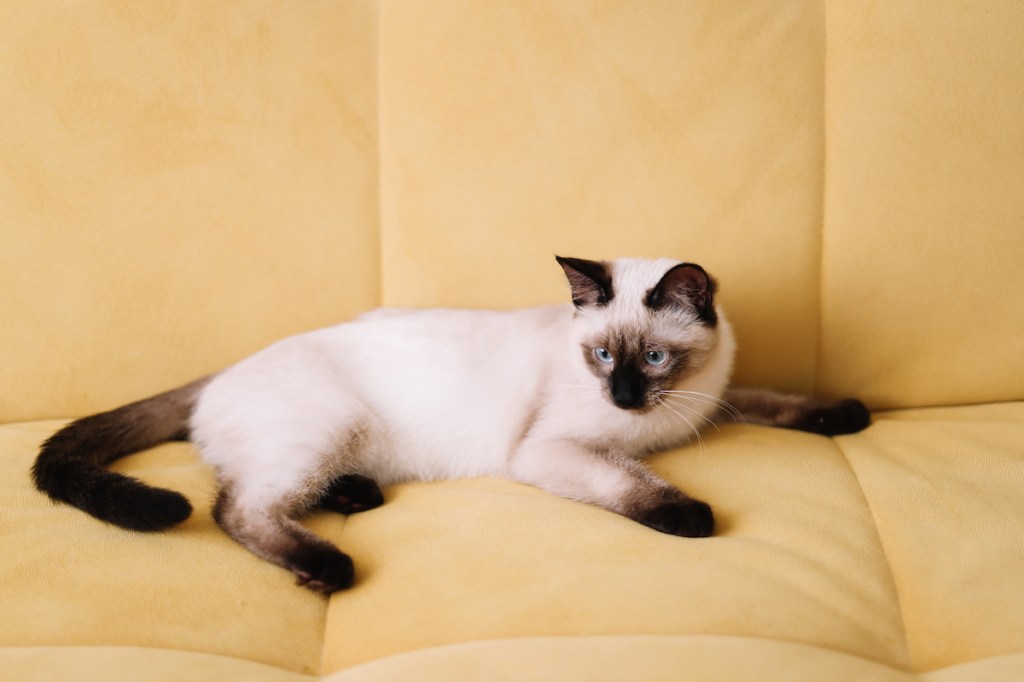Why Do Cats Have White Paws? Vets Weigh in on the Fascinating Science of Cat Colors
There's a complex genetic process behind those precious socks!

There’s nothing cuter than a cat with little white paws. The sight of a cat that appears to be wearing gloves and socks is an instant mood booster, and there’s something charmingly cartoon-like about a two-tone kitty. If you’re the lucky owner of a white-pawed cat, you may have wondered what, exactly, caused this distinctive coat coloring.
Recently, a social media post stating, “Read somewhere yesterday that the reason cats often have white paws and bellies but never the opposite is bc in utero their color starts developing at their spine and moves out and anything that isn’t finished by the time they are born is white and I can’t stop thinking about it” has been going viral, leading people all over the internet to share photos of their own cats with comments about how “cooked” they are. Confused? By this logic, a fully black cat is “fully cooked,” a fully white cat is “uncooked,” and a black-and-white cat is “medium rare” (you can see some examples in this Instagram post).

So, is there any truth to this popular post, or is it just a cutesy myth invented to rack up the likes? It turns out the answer to the question of why do cats have white paws is a bit complicated. Here’s what vets have to say about the fascinating science behind your cat’s white socks and bellies.
The power of piebald
“A lot of genetics goes into cat coat patterns and colors,” says Dr. Grant Little, a veterinarian and expert for JustAnswer. When a cat (or other animal) has white spots, it’s known as piebald. “This is a genetic feature where the melanin does not fully mature in the hair cells and it can be more common in the extremities than it is in the body portion for most cats,” explains Dr. Little. Piebalding is powerful and leads to some seriously eye-catching coats. “Piebalding can overtake the original coloring of the cat, and that’s why you’ll see an orange cat with white socks or a black cat with patches of white on its legs or chest,” says Dr. Little.

Magic melanocytes
The dark areas of a cat’s coat come from pigment-producing cells known as melanocytes. “The precursor cells of melanocytes in an embryo come from an area called the neural crest, which is located in the area on the back that becomes the spine,” says Dr. Lindsey Wendt, veterinarian and Chief Veterinary Officer for Antelope Pets.
Dr. Wendt shares that there is an element of truth to the viral post: “One theory is that these precursor cells migrate across the skin surface, starting in the ‘spinal’ area and then expanding, but they don’t reach the furthest areas such as the paws, tip of the face and belly, leading to the absence of pigment cells and therefore a white coat.” However, this isn’t known for sure, as she elaborates: “The second theory is that the precursor pigment cells migrate evenly across the entire skin surface, but there is an opposing genetic or cellular mechanism that works in the opposite direction and causes them not to survive, therefore leaving white extremities.”

While it’s possible that dark fur may begin developing from the spine outward, Dr. Little is quick to note that color development doesn’t have to do with timing, as the post suggests. “As funny as it is to think that the cat isn’t ‘fully baked,’ and I did get a chuckle out of the humor, white paws would be related to in utero changes and would be unrelated to staying in the womb for a few extra hours or anything like that,” he says.
Evolutionary effects
White paws should also be considered from an evolutionary perspective, says Dr. Annie Valuska, pet behavior scientist at Purina. “The fact that cats have white in their coats at all is interesting, especially when you consider that for mesopredators like cats (i.e., middle of the food chain), such distinctive markings would help them stand out to both potential predators and potential prey, which is not ideal.”

The presence of white paws “suggests that humans may have played a role in actively selecting for traits like white ‘socks’ during the process of domestication,” notes Dr. Valuska. “And to further add to the story, the genetic mechanisms underlying domestication are likely responsible for those white markings appearing in the first place.” As she explains, when it comes to domestic animals like cats and dogs, “across species, the behavioral traits that are selected for during domestication (such as friendliness or boldness) are genetically linked to physical traits, like curled tails, floppy ears — and piebald coats that include white spots.”
Colorpoint restriction
While the vets all say there is some accuracy to the post, it doesn’t tell the whole story. Cats with light coats and dark paws are much rarer than cats with dark coats and light paws, but they do exist! “Cats with light coats and black paws are considered to have colorpoint restriction,” says Dr. Wendt. “This means they have a genetic mutation that affects the temperature-sensitive pigments, leading to reduced pigment in warmer areas of their body (their trunk) and darker pigmentation in their extremities (ear tips, toes, tail tips and face).” This kind of coat is most often seen in purebred Siamese cats.

Another fun fact about colorpoint restriction? “Since pigment is only produced at the coldest parts of the body, Siamese kittens are born solid white because they were nice and warm in the womb!” says Dr. Valuska.
Wonderful white socks
While the genetic process which yields white paws is much more complex than that adorable social media post suggests, there is a surprising kernel of truth to be found in the idea of darker colors starting at the spine. Knowing the intricate scientific theories of why cats have white paws just makes us appreciate those sweet socks even more!
Read on for more fascinating cat facts!
Why Do Cats Wag Their Tails? Vets Decode the Secret Messages They’re Trying to Send
Do Cats Dream? Vet Reveals What Really Goes On In Feline Heads While They Sleep
Orange Cat Behavior: Vets Explain the Quirks That Make These Colorful Kitties So Special














